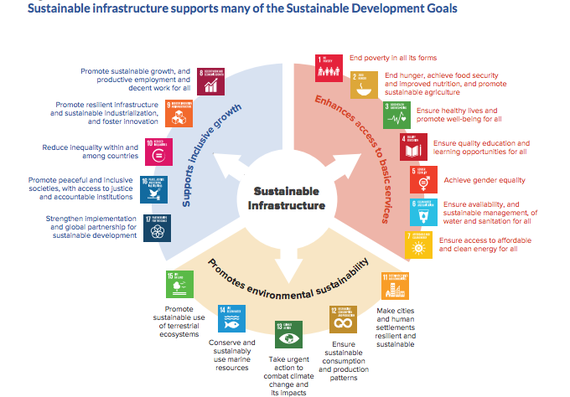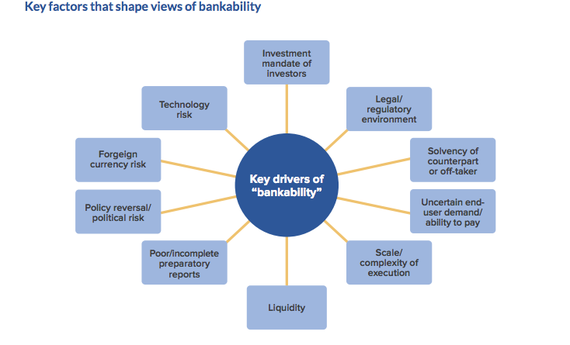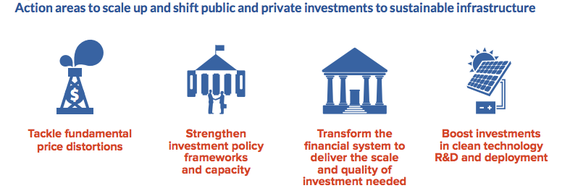At GGGI we believe that attracting increased investment to sustainable infrastructure is essential for green growth. It is a central discussion topic for both the Sustainable Development Goals (SDGs) and the Paris Agreement on Climate Change. The world needs to invest in resilient and sustainable infrastructure for a triple win: (1) boost growth, (2) create a more inclusive future and (3) tackle global warming. This is a key message of New Climate Economy's 2016 report on 'The Sustainable Infrastructure Imperative: Financing for Better Growth and Development'. GGGI is one of the partners supporting the New Climate Economy project.
All countries - developed and developing countries alike - need to act now on climate change if we are to reduce emissions to relatively safe levels, of 2 degrees Celsius with an aspiration of 1.5 degrees Celsius.

Source: New Climate Economy's 2016 report: 'The Sustainable Infrastructure Imperative: Financing for Better Growth and Development'
Looking back, 2015 was a momentous year. The most notable milestones on the climate change and development front last year were the International Conference on Financing for Development in Addis Ababa; the Sustainable Development Summit in New York and the COP21 Climate Change Conference in Paris. The Paris summit was a political triumph in that it put the international climate process back on track. Last week's Kigali Amendment to the Montreal Protocol that phases out HFCs is another significant climate mitigation step the world has taken to deliver on the Paris Agreement and the Sustainable Development Goals.
Moving forward, mobilizing investment for green growth, of which climate change is a cross cutting theme, is crucial but challenging to address. Although financial resources may be available, according to the New Climate Economy's 2014 report, Better Growth, Better Climate; only 3% of the 60 trillion dollar investment made in 2013 by institutional investors was put into long-term investment in infrastructure. Profit considerations will remain the main driving force behind private investment. Investors need to be convinced about the bankability of projects in an increasingly volatile geo-political environment.

Source: New Climate Economy's 2016 report: 'The Sustainable Infrastructure Imperative: Financing for Better Growth and Development'
Effective regulatory policies and mechanisms need to be in place to help unlock and accelerate investment for climate-smart infrastructure projects. A top priority for GGGI is to assist countries to develop pipelines of projects that are investment-ready. GGGI is attempting to change the direction of investment more towards climate smart and green growth investments by building capacity of governments in designing bankable projects, initiating and pilot testing de-risking instruments and blended financing and helping governments to access international climate finance.

Source: New Climate Economy's 2016 report: 'The Sustainable Infrastructure Imperative: Financing for Better Growth and Development'
An action plan for financing sustainable infrastructure needs to be drawn up to address investment barriers. More money alone won't do the job. NCE's Sustainable Infrastructure Imperative Report notes there are four ways to build sustainable infrastructure and overcome obstacles. First, collective action must be taken to deal with fundamental price distortion to enhance incentives for investment and innovation. This unified effort will contribute significantly to reducing pollution and congestion and ultimately generate profit that can be redirected to help the poor. Second, strong policy frameworks and institutional capacities must be reinforced to generate enabling conditions for investment to build pipelines of sustainable projects. Third, the financial system must be transformed to deliver the scale and quality of investment needed in order to increase financing from all sources, including private investors. Last, mobilizing finance and scaling up investments in clean technology R&D and deployment are pivotal to reducing the costs and enhancing the accessibility of more sustainable technologies.
The report also states that the world is expected to invest US$90 trillion in infrastructure over the next 15 years to combat climate change and ensure that this money is spent on low-carbon, energy-efficient projects. The report adds that both developed and developing countries will face different infrastructure challenges in the 21st century. Developed countries will have to replace or repair aging infrastructure, while the majority of construction of new infrastructure will happen in low and middle income countries. There needs to be better deployment and mobilization of finance and investment from domestic and external sources, including national and local governments, multilateral and development banks, private companies and institutional investors.
To overcome the barriers, national action plans for financing sustainable infrastructure need to be put in place while investment priorities and the financial system should be reviewed by national and international actors. GGGI will work hard to support its member governments to green their investments to deliver inclusive, pro-poor green growth, as well as climate action.
